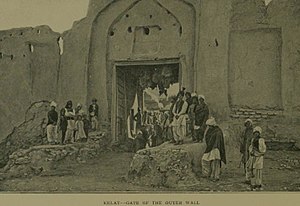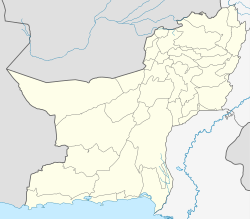Kalāt or Qalāt (Brahui/Balochi: قلات), historically known as Qīqān,[2][3] is a historic town located in Kalat District, in Pakistan's Balochistan province. The town of Kalat is the headquarter of Kalat District and is known locally as Kalat-e-Brahui and Kalat-e-Sewa.[4]
Kalat
قلات Qalāt | |
|---|---|
District Headquarter / City | |
 Outer wall of Kalat city | |
| Coordinates: 29°01′48″N 66°35′20″E / 29.030°N 66.589°E | |
| Country | Pakistan |
| Region | Balochistan |
| District | Kalat |
| Government | |
| • Type | City |
| Area | |
| • Total | 489 km2 (189 sq mi) |
| Elevation | 2,007 m (6,585 ft) |
| Population (2017)[1] | |
| • Total | 36,796 |
| Time zone | UTC+5 (PST) |
| Area code | +92844 |
Qalat, formerly Qilat, is located roughly in the center of the Balochistan province, It was the capital of the Kalat Khanate. The Khan of Kalat is presently a ceremonial title held by Mir Suleman Dawood Jan, and the Pakistan government has made efforts to reconcile with him; his son, Prince Mohammed, who is next in line to be the Khan of Kalat, is pro-Pakistan.[5]
Climate
editKalat features a cold desert climate (BWk) under the Köppen climate classification. The average temperature in Kalat is 14.1 °C (57.4 °F), while the annual precipitation averages 163 mm (6.4 in). June is the driest month with 1 mm (0.039 in) of rainfall, while January, the wettest month, has an average precipitation of 36 mm (1.4 in).
July is the warmest month of the year with an average temperature of 24.8 °C (76.6 °F). The coldest month January has an average temperature of 3.4 °C (38.1 °F). The all-time lowest recorded temperature in Kalat was −17 °C (1 °F) on 20 January 1978,[6] while the highest temperature ever recorded was 38 °C (100 °F) on 19 June 1977.
| Climate data for Kalat | |||||||||||||
|---|---|---|---|---|---|---|---|---|---|---|---|---|---|
| Month | Jan | Feb | Mar | Apr | May | Jun | Jul | Aug | Sep | Oct | Nov | Dec | Year |
| Mean daily maximum °C (°F) | 10.3 (50.5) |
12.1 (53.8) |
17.1 (62.8) |
22.1 (71.8) |
27.4 (81.3) |
31.9 (89.4) |
32.6 (90.7) |
31.7 (89.1) |
28.6 (83.5) |
23.3 (73.9) |
17.5 (63.5) |
13.1 (55.6) |
22.3 (72.2) |
| Daily mean °C (°F) | 3.4 (38.1) |
5.3 (41.5) |
9.8 (49.6) |
14.3 (57.7) |
18.9 (66.0) |
22.7 (72.9) |
24.8 (76.6) |
23.4 (74.1) |
19.4 (66.9) |
13.8 (56.8) |
8.6 (47.5) |
4.9 (40.8) |
14.1 (57.4) |
| Mean daily minimum °C (°F) | −3.5 (25.7) |
−1.5 (29.3) |
2.6 (36.7) |
6.6 (43.9) |
10.5 (50.9) |
13.5 (56.3) |
17.0 (62.6) |
15.2 (59.4) |
10.3 (50.5) |
4.3 (39.7) |
−0.2 (31.6) |
−3.3 (26.1) |
6.0 (42.7) |
| Source: Climate-Data.org[7] | |||||||||||||
Demographics
editThe population is mostly Muslim (97 percent), with a Hindu population of three percent,[8] out of which many are Hindkowan merchants who regard Kalat as their homeland.[9][10]
| Religious group |
1941[11]: 13–14 | 2017[12][13] | ||
|---|---|---|---|---|
| Pop. | % | Pop. | % | |
| Islam | 2,049 | 83.19% | 35,547 | 96.61% |
| Hinduism | 381 | 15.47% | 1,234 | 3.35% |
| Sikhism | 33 | 1.34% | — | — |
| Christianity | 0 | 0% | 13 | 0.04% |
| Ahmadiyya | — | — | 2 | 0.01% |
| Total population | 2,463 | 100% | 36,796 | 100% |
Kalat Kali Temple
editThere is a Hindu temple devoted to Kali.[14] On 21 December 2010, the 82 year old chief-priest was abducted in what was reported as part of increasingly routine targeting of minority Hindus in the province.[15]
History
editIt has been known in earlier times as Kalat-i-Seva (from a legendary Hindu king) and Kalat-i Nichari which connects it with the Brahui Speaking tribes of Nichari, which is generally accepted as belonging to the oldest branch of the indigenous Brahois[16]
The town of Kalat is said to have been founded by and named Qalat-e Sewa (Sewa's Fort), after Sewa, a legendary hero of the Brahui people.
The Brahui Speaking tribes arrived from east in the Qalat area way before the arrival of Balochi speaking tribes from the west. The Brohis established a large kingdom in the 15th century, but it soon declined and the region fell to Mughals for a short period. The brahui speaking Khans of Qalat were dominant from the 17th century onwards until the arrival of the British in the 19th century. A treaty was signed in 1876 to make Qalat part of the British Empire.
In 1947, the Khan of Kalat reportedly acceded to the dominion of Pakistan. In 1948, Qalat became part of Pakistan when the British withdrew. The last Khan of Qalat was formally removed from power in 1955, but the title is still claimed by his descendants. The current Khan of Qalat is Mir Suleman Dawood Khan Ahmadzai.
References
edit- ^ ""Final Results of Census-2017 Table 2: Urban localities by population size and their population by sex, annual growth rate and household size"" (PDF).
- ^ Baig, Zeeshan Muhammad (December 10, 2017). "باب الاسلام سندھ ؛ محمد بن قاسم سے قبل سندھ پر حملے کی اسلامی جنگی مہمات". Express.
- ^ Asif, Manan Ahmed (September 19, 2016). A Book of Conquest. Harvard University Press. ISBN 9780674660113 – via Google Books.
- ^ Viking fund publications in anthropology, Issue 43. Viking Fund. 1908. Retrieved 2008-08-17.
Below the citadel lies a Hindu temple of Kāli, probably of pre-Muhammadan date.
- ^ Shahid, Saleem (June 29, 2015). "Khan of Kalat being persuaded to return home". DAWN.COM.
- ^ "Historical Events". rmcbalochistan.pmd.gov.pk. Retrieved 2021-10-07.
- ^ "Climate: Kalat - Climate-Data.org". Retrieved 9 September 2016.
- ^ Encyclopædia Britannica: a new survey of universal knowledge, Volume 3. Encyclopœdia Britannica. 1964. Retrieved 2008-08-17.
Almost all the people are Muslim ; the largest Hindu minorities are in the Sibi (9%) and Kalat (2%) districts.
- ^ Viking fund publications in anthropology, Issue 43. Viking Fund. 1966. Retrieved 2008-08-17.
...is in the hands of a small caste of Hindu merchants. These Hindus are Hindko-speaking and regard Kalat as their homeland, where they generally keep their families and go for some months every year to visit and to obtain supplies. While in the Marri area, they must be under the protection of a local Marri chief or the sardar himself.
- ^ The social organization of the Marri Baluch. Indus Publications. 1977. Retrieved 2008-08-17.
...is in the hands of a small caste of Hindu merchants. These Hindus are Hindko-speaking and regard Kalat as their homeland, where they generally keep their families and go for some months every year to visit and to obtain supplies. While in the Marri area, they must be under the protection of a local Marri chief or the sardar himself.
- ^ "CENSUS OF INDIA, 1941 VOLUME XIV BALUCHISTAN". Retrieved 27 January 2023.
- ^ "Final Results (Census-2017)". Retrieved 27 January 2023.
- ^ "District Wise Results / Tables (Census - 2017) TABLE 9 - POPULATION BY SEX, RELIGION AND RURAL/URBAN" (PDF). Retrieved 27 January 2023.
- ^ Notezai, Muhammad Akbar (2017-10-15). "FOOTPRINTS: DESCENDANTS OF ROYALTY". DAWN.COM. Retrieved 2022-05-24.
- ^ Baabar, Mariana (2022-02-05). "No Country For Kafirs?". Outlook.
- ^ E.J. Brill's first encyclopaedia of Islam, 1913–1936, Volume 4 By M. Th. Houtsma, Martijn Theodoor Houtsma Page 678

